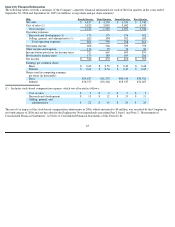Apple 2006 Annual Report Download - page 63
Download and view the complete annual report
Please find page 63 of the 2006 Apple annual report below. You can navigate through the pages in the report by either clicking on the pages listed below, or by using the keyword search tool below to find specific information within the annual report.
were sold at 99.925% of par for an effective yield to maturity of 6.51%. Total deferred gain resulting from the closure of debt swaps of
approximately $23 million was fully amortized as of the notes’ maturity in February 2004.
Provision for Income Taxes
The Company’s effective tax rate for the year ended September 30, 2006 was approximately 29%. The Company’s effective rate differs from
the statutory federal income tax rate of 35% due primarily to certain undistributed foreign earnings for which no U.S. taxes are provided
because such earnings are intended to be indefinitely reinvested outside the U.S. In addition, the Company recorded a tax benefit of $20 million
due to settlement of prior year tax audits in the U.S., and a net benefit of $20 million resulting from the dividend repatriation under the
American Jobs Creation Act of 2004 (“AJCA”) and international tax planning strategies associated with the repatriation as further discussed
below.
As of September 30, 2006, the Company had deferred tax assets arising from deductible temporary differences, tax losses, and tax credits of
$739 million before being offset against certain deferred liabilities and a valuation allowance for presentation on the Company’s balance sheet.
Management believes it is more likely than not that forecasted income, including income that may be generated as a result of certain tax
planning strategies, together with the tax effects of the deferred tax liabilities, will be sufficient to fully recover the remaining deferred tax
assets. As of September 30, 2006 and September 24, 2005, a valuation allowance of $5 million was recorded against the deferred tax asset for
the benefits of state operating losses that may not be realized. The Company will continue to evaluate the realizability of the deferred tax assets
quarterly by assessing the need for and amount of the valuation allowance.
On October 22, 2004, the AJCA was signed into law. The AJCA included a provision for the deduction of 85% of certain foreign earnings that
were repatriated, as defined in the AJCA, within a specified time frame. Among other requirements, dividends qualifying for the 85%
deduction must be reinvested in the United States in certain qualified investments pursuant to a domestic reinvestment plan approved by the
CEO and Board of Directors. During 2006, the Company repatriated approximately $1.6 billion of foreign earnings. Of the earnings
repatriated, $755 million is eligible for the reduced tax rate provided by the AJCA. Accordingly, the Company recorded a tax charge of $51
million related to the repatriation of foreign earnings under the provisions of the AJCA. In addition, the Company recorded a tax benefit of
$71 million resulting from the implementation of tax planning strategies to recognize deferred tax assets that were previously not recognizable
within certain foreign subsidiaries.
The Internal Revenue Service (“IRS”) has substantially completed its field audit of the Company’s federal income tax returns for the years
2002 through 2003 and proposed certain adjustments. The Company intends to contest certain of these adjustments through the IRS Appeals
Office. Substantially all IRS audit issues for years prior to 2002 have been resolved. In addition, the Company is subject to audits by state,
local, and foreign tax authorities. Management believes that adequate provision has been made for any adjustments that may result from tax
examinations. However, the outcome of tax audits cannot be predicted with certainty. Should any issues addressed in the Company’s tax audits
be resolved in a manner not consistent with management’s expectations, the Company could be required to adjust its provision for income tax
in the period such resolution occurs.
62
























